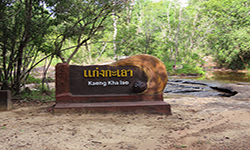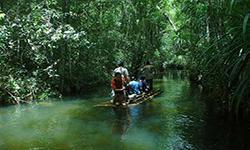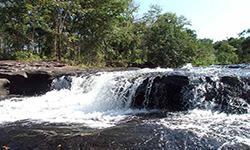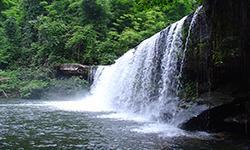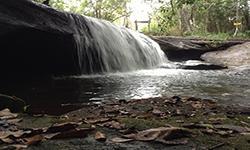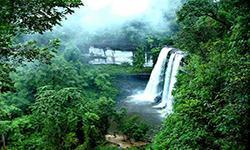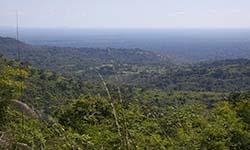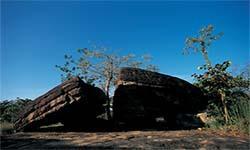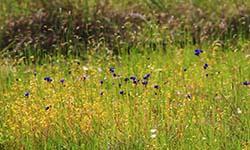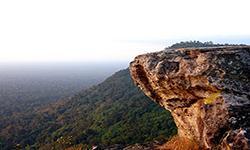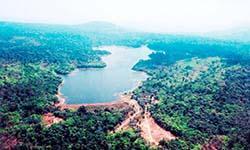Phu Chong Na Yoi National Park
Contact Location : National Park Headquarters, Moo. 3, Na Chaluai Sub-district, Na Cluai District, Ubon Ratchathani Province, 34280
Telephone Number : (+66) 4 521 0706 , (+66) 4 232 5741
Email : phuchong2550@hotmail.com
Facebook : Phu Chong Na Yoi National Park
Information
Phu Chong Na Yoi National Park is located in Buntharik, Na Chaluai, and Nam Yuen District, Ubon Ratchathani Province which borders with Laos and Cambodia. The forest area is part of the Phanom Dong Rak Mountain range, consisting of many Phu Lek Mountains, such as Phu Chong Na Yoi, Phu Chong Nam Sup, Phu Chong, Phu Chan Daeng, Phu Plan Sung, and Phu Plan Yao. There is abundant wildlife and beautiful natural surroundings. It is approximately 428,750 rai, or 686 square kilometers.
Background
Mr. Narong Devakupt, a police lieutenant and member of the House of Representatives of Ubon Ratchathani province, wrote a letter dated November 15, 1982, to the Royal Forest Department proposing the Phu Chong-Na Yoi Forest development project to become a national park in response to the needs of the people of Na Chaluai District and nearby districts in Ubon Ratchathani Province to protect and maintain the forest that is fertile and a beautiful natural environment as a tourist attraction. The National Park Division, Royal Forest Department, has issued an order No. 116/2526 dated January 19, 1983, for Mr. Anusak Sithong, Forestry Officer 3, to survey the area.
The survey results show that the condition of the forest area is fertile. Many wildlife species are abundant. And there are many beautiful natural sceneries. According to the survey report No. Ko So 0713 (Pho Cho)/Special dated April 12, 1983, in order to meet the people's needs to conserve the Phu Chong-Nai Yoi Forest, Mr. Ken Prakhamthong, Udomdet District residents of Ubon Ratchathani Province, has a letter dated June 1, 1983, to the Deputy Minister of Agriculture and Cooperatives accelerating the establishment of this national park. Later on, the National Park Division has expedited the survey to find more information and found that the Phu Chong-Na Yoi Forest area has beautiful scenery and is suitable to be established as a national park, acording to Phu Chong Forest Park Book No. Ko Ho 0713 (Pho Cho)/77, dated August 9, 1984.
The National Park Division, Royal Forest Department, has presented to the National Park Board which resolved in the meeting No. 3/1984 on September 12, 1984, and agreed to designate the forest area as a national park. There has been a royal decree specifying the area of Phu Chong-Na Yoi Forest land in Huai Kha Sub-district, Buntharik District, Na Chaluai Sub-district, Na Chaluai District, and Dom Pradit Sub-district, Nam Yuen District, Ubon Ratchathani Province to be a national park, as published in the Government Gazette, Volume 104, Part 103, dated June 1, 1987. This is the 53rd national park in the country.
Note : After paying the entrance fee to the National Park, please carry the receipt for inspection.
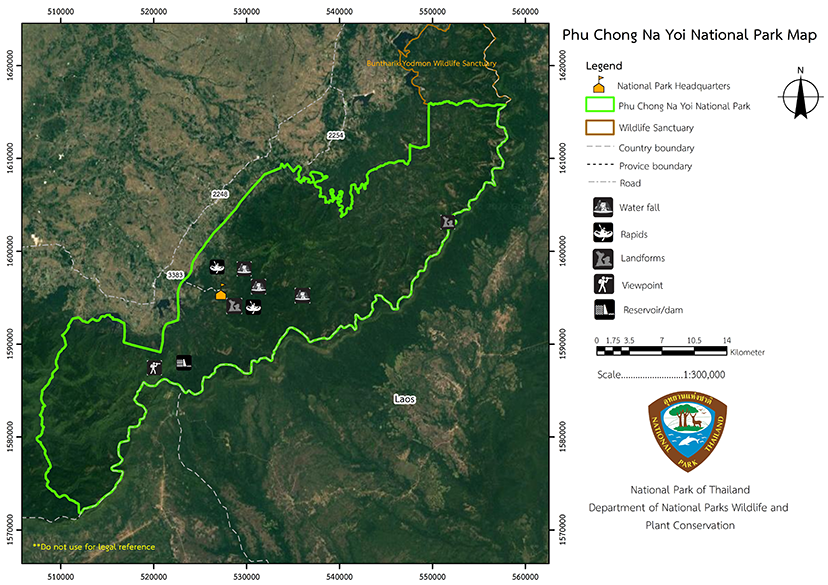
428,750 rai (686 square kilometers)
|
|
|
||
|
Kaeng Sila Thip |
Koeng Mae Fong Waterfall |
||
|
Pra On La O Waterfall |
Sarali Phirom Waterfall |
||
|
Huai Luang Waterfall |
Noen 500 (hill 500) |
||
|
Phlan Kong Kwian |
Phlan Pha Chat |
||
|
Phu Hin Dang |
Phlan Suea Ton Bon Reservoir |
||
Nature trails ⇔ Trekking ⇔ Visit Waterfall ⇔ Observe flowers/plant ⇔ Bird/Butterfly ⇔ Stargazing ⇔ Mountain biking ⇔ History/Culture ⇔ Camping
Welfare shop : (coffee, water, and snacks) is open daily from 8.30 - 16.30 hrs.
Mobile phone signal :
National Park Headquarters: AIS, TRUE, DTAC
|
|
Phu Chong Na Yoi National Park covers some parts of Buntharik, Na Chaluai, and Nam Yuen District in Ubon Ratchathani Province. It borders with the Lao People's Democratic Republic and Cambodia. The forest areas are part of Phanom Dong Rak mountain range and mostly are plains with slopes downward to the south. It comprises many small and complex mountain ranges such as Phu Chong Na Yoi, Phu Chong Nam Sap, Phu Chan Daeng, and Phu Phlan Yao. The average altitude is about 300-600 meters. The forest conditions are generally dry evergreen forests, mixed deciduous forests, and deciduous dipterocarp forests. Phu Chong Na Yoi National Park has dense vegetation, accounting for about 75% of the total area, with beautiful natural conditions. The forest conditions are perfect, and many "Ton Chong," or Malva nut trees, have been found in the area, which is the origin of the park's name, and "Na Yoi" comes from the word "Nam Yoi," (dropping water) which represents a wealth of watersheds and streams. There is water flowing down from the overhang stones adjacent to the waterfall. There are also various important rivers such as the Lam Dome Noi, the Lam Dome Yai, and the Luang Creek. In Phu Chong Na Yoi National Park, apart from still being dense with forests and abundant wildlife, there are many interesting sights and attractions. Water Resources, Watersheds, Watershed Quality Classification The main watersheds of Phu Chong Na Yoi National are the Mun River Basin and its tributary basins which are Lam Dome Yai and Lam Dome Noi River basins, most of which are classified into the watershed class 3, accounting for 34.12%, followed by the class, covering the parking area for 51.76%. Characteristics of the canal area within Phu Chong Na Yoi National Park are long, flowing in the direction from the west to the east, consisting of Lam Dome Yai, originated from the headwater in the Nam Yuen District, flowing towards north to converge with the Mun Stream at Phibusmangsahan District, Ubon Ratchathani Province, and flowing into the Mun River, and Lam Dom Noi, whose watershed is in the area of Buntharik District, Ubon Ratchathani Province. Other important surface water resources in the vicinity of Phu Chong Na Yoi National Park are medium-sized reservoirs, namely Huai Plan Suea Reservoir (Huai Phueng) and Huai Chanla Reservoir and small-sized reservoirs, namely Waichaluai and Huai Pongling reservoirs. Phu Chong Na Yoi National Park's has 62 sub-catchments with a total water intake area of approximately 71,060 square kilometers. Based on the estimation of the water volume model in the stream, the average rainfall during the last 30 years was about 1,587.4 mm. As shown in Figure 8, the average annual water volume of the river is about 17 million cubic meters or approximately 132.28 mm. in height. The month with the highest water content in the stream is September, with an average of about 43 million cubic meters and January is a month with very little water (less than 1 million cubic meters). |
Phu Chong Na Yoi National Park is located in the tropical Savannah climate zone, which means a clear difference between the rainy and dry seasons. There is a long day in summer. The annual average high temperature is about 35.9 degrees Celsius. The yearly average rainfall is 1,125.6 mm; the average maximum rainfall in August is about 322.6 mm; and the annual average relative humidity is 72.9%.
|
|
|
|
|
Biological Resources Phu Chong Na Yoi National Park’s forest conditions can be divided into different types based on topographic factors, climate, soil characteristics and plant characteristics as follows. Decidouous Forest Plant Community (1) Deciduous Dipterocarp Forest: The forests are generally sparse. The soil is not ideal, the topsoil is shallow, and the trees are small, with the exception of some areas where the topsoil is thick and has not been disturbed excessively. The trees are a mix of large and medium-sized. The essential plants are Burma Sal, Shorea siamensis, White - Meranti, Hairy Keruing, and Dipterocarpus intricatus Dyer. (2) Mixed Deciduous Forest or mixed deciduous forest. The Evergreen Forest community by the (1) Dry Evergreen Forest Wildlife (1) Mammals: Mammals are found such As Serow, Sambar Deer, Barking Deer, Lesser Mousedeer, Wild Boar, Civet Musk, Binturong, Dhole, Hog Badger, Burmese Hare, Gibbon, Bull, etc. (2) Birds: There are about 150 species of birds, the most important of which are ducks. (3) Reptiles such as Tokay, Lizards, Elongated Tortoises, Ground Lizards, Burmese Pythons, King Cobras, Cobras, etc. (4) Amphibians such as Asian Common Toads, Stripe-Backed Frogs, Chinese Edible Frogs, and Tree Frogs. |
How to get there by car :
From Bangkok, you can get there by trains and public bus to Ubon Ratchathani. From the town of Ubon Ratchathani Province to Na Chaluai District, the distance is about 100 kilometers. If traveling by car, it is recommended to use the route Ubon Ratchathani-Warin Chamrap District, Det Udom, Nam Yuen, and Na Chaluai District, a total distance of 140 kilometers. Before reaching Na Chaluai District about 10 kilometers, there is a junction at Ban Kaeng Rueang leading to the National Park.
- National Park Ranger Station Pho Cho No. 1 (Phlan Kong Kwian)
- National Park Ranger Station Pho Cho No. 2 (Phlan Sung)
- National Park Ranger Station Pho Cho No. 3 (Kam Bak)
- National Park Ranger Station Pho Cho No. 4 (Chanla)
- National Park Ranger Station Pho Cho No. 5 (Mot Ngam)
- National Park Ranger Station Pho Cho No. 6 (Kaeng Rueang)
- Accommodation - Phu Chong 101 (Daeng Ubon)
- Accommodation -Phu Chong 103/1-4 (Mani Thewa)
- Accommodation -Phu Chong 102 (Yat Nam Khang)

